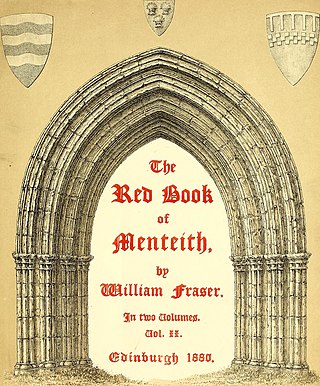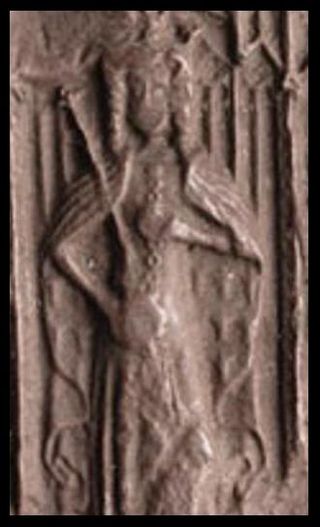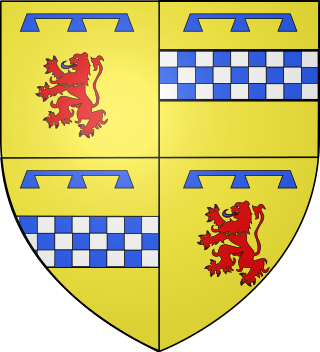There are currently two earldoms of Mar in the Peerage of Scotland, and the title has been created seven times. The first creation of the earldom is currently held by Margaret of Mar, 31st Countess of Mar, who is also clan chief of Clan Mar. The seventh creation is currently held by James Erskine, 14th Earl of Mar and 16th Earl of Kellie, who is also clan chief of Clan Erskine.
The Earl of Fife or Mormaer of Fife was the ruler of the province of Fife in medieval Scotland, which encompassed the modern counties of Fife and Kinross. Due to their royal ancestry, the earls of Fife were the highest ranking nobles in the realm, and had the right to crown the king of Scots.

The Earl or Mormaer of Lennox was the ruler of the region of the Lennox in western Scotland. It was first created in the 12th century for David of Scotland, Earl of Huntingdon and later held by the Stewart dynasty.

The Mormaer or Earl of Menteith was the ruler of the province of Menteith in the Middle Ages. The first mormaer is usually regarded as Gille Críst, simply because he is the earliest on record. The title was held in a continuous line from Gille Críst until Muireadhach IV, although the male line was broken on two occasions. A truncated version of the earldom was given two years later to Malise Graham, 1st Earl of Menteith, in compensation for loss of the Earldom of Strathearn.

Murdoch Stewart, Duke of Albany was a leading Scottish nobleman, the son of Robert Stewart, Duke of Albany, and the grandson of King Robert II of Scotland, who founded the Stewart dynasty. In 1389, he became Justiciar North of the Forth. In 1402, he was captured at the Battle of Homildon Hill and would spend 12 years in captivity in England.
Inchmurrin is an island in Loch Lomond in Scotland. It is the largest fresh water island in the British Isles.
Níall of Carrick was the second man to bear the title Mormaer, or Earl, of Carrick. He was successor of mormaer Donnchadh of Carrick. Originally he was believed to be the son of Donnchadh, however, it is now believed that he was more likely his grandson, the son of Donnchadh's oldest son and heir Cailean mac Donnchadh. Cailean, also known as Colin and Nicholaus of Carrick, predeceased his father and therefore upon Donnchadh's death in 1250, the title of Mormaer came to Niall. It has been suggested that Cailean's wife, Niall's mother, was a daughter of Niall Ruadh, briefly king of Tir Eoghain. Niall's grandfather Donnchadh held lands in Ireland, such a marriage of his son would have reinforced Donnchadh's Irish alliances and would account for the use of the name Niall. It would also explain the strong alliance with the Ó Neill held by Niall's grandsons. As the son of Cailean, Niall had one sister, Afraig, who married Gilleasbaig of Menstrie, a baron of Clackmannanshire who was the first attested man to bear the surname "Campbell".

Máel Coluim II, was a 13th-century Mormaer of Fife who ruled the mormaerdom or earldom of Fife between 1228 and 1266. He was the nephew of Máel Coluim I, the previous mormaer, and the son of Máel Coluim I's brother Donnchadh, son of Donnchadh II.

Donnchadh IV, Earl of Fife [Duncan IV] (1289–1353) was a Scottish nobleman who was Guardian of Scotland and the last native Scottish Mormaer of Fife from 1289 until his death.
Mormaer Domhnall of Lennox ruled Lennox in the years 1333–1365. He succeeded his father Maol Choluim II.
Baltar mac Amlaimh, also called Walter of Faslane, was the de facto Mormaer of Lennox through his wife Margaret between 1365 and 1385.

Isabella of Lennox was the ruler of Lennox, at least from 1437 to 1458, and last in the line of Mormaers or native Scottish rulers. As the wife of Murdoch Stewart, 2nd Duke of Albany, she was also Duchess of Albany (1420–1425), but in 1425 her family would be almost completely destroyed when her husband, father and two sons were executed by King James I of Scotland because of their rebellion. Only one son, James the Fat, would escape their family's punishment, and he would die in exile in Ireland. Isabella succeeded in escaping the fate of her family, and would eventually regain her title and estates, retiring to her castle in Loch Lomond where she raised her grandchildren. She would eventually live to see the assassination of her family's opponent, King James. Though none of her four sons survived her, her grandson Andrew Stewart, 1st Lord Avandale would in time rise to become Lord Chancellor of Scotland.

Clan Lennox is a Lowland Scottish clan. The clan chiefs were the original Earls of Lennox, although this title went via an heiress to other noble families in the fifteenth and sixteenth centuries. The chiefship of the clan then went to the Lennox of Woodehead branch.

Clan Mar is a Scottish clan of the Scottish Lowlands. It is also officially known as the Tribe of Mar. The chiefs of the Clan Mar were the original Earls of Mar, although this title later went via an heiress to the Douglases in the late fourteenth century, and then to the Stewarts before going to the Erskines. The current chief of Clan Mar is Margaret of Mar, Countess.
Alexander Leslie, Earl of Ross was a Scottish nobleman. Born between 1367 and 1382, he was the son of Walter Leslie, Lord of Ross and Euphemia I, Countess of Ross. In around 1394, or not later than 1398, he became Earl of Ross and sometime before 1398 he married Isabel Stewart, daughter of Robert Stewart, Earl of Fife who became Robert Stewart, Duke of Albany. They had one child, Euphemia. He died at Dingwall, Scotland on 8 May 1402.
Mariota, Countess of Ross was the daughter of Euphemia I, Countess of Ross and her husband, the crusading war-hero Walter Leslie, Lord of Ross. Upon the death of her brother, Alexander Leslie, Earl of Ross, she became the heir-presumptive of her niece Euphemia II, Countess of Ross although her husband Domhnall of Islay, Lord of the Isles pressed Mariota's superior claim to the earldom.

James Mor Stewart, called James the Fat, was the youngest son of Murdoch Stewart, Duke of Albany and Isabella of Lennox. When his father and brothers were executed by King James I for treason in 1425, James led a rebellion against the king, taking the town of Dumbarton and killing the keeper of Dumbarton Castle. His success was short lived and he soon fled to Ireland, where he would spend the remainder of his life in exile. A second attempt at rebellion in 1429 saw a fleet sail to Ireland to collect James "to convey him home that he might be king", but he died before the attempt could be made.
William Douglas, 2nd Earl of Angus was a Scottish nobleman and soldier. The son of George Douglas, 1st Earl of Angus and Princess Mary of Scotland, he was a grandson of King Robert III.

Andrew Stewart was Lord Chancellor of Scotland from 1460 to 1482 and one of the leading servants of King James III of Scotland.
Margaret Graham, Countess of Menteith was a Scottish noblewoman. She held the title Countess of Menteith in her own right, having inherited the title c. 1360 from her mother, Mary, Countess of Menteith, who was married to Sir John Graham. Graham was styled Earl of Menteith during his marriage with Mary, whom he predeceased. The Menteith region was situated partially in southwest Perthshire and partly in Stirlingshire.